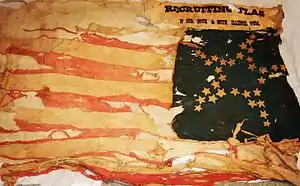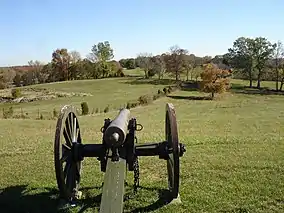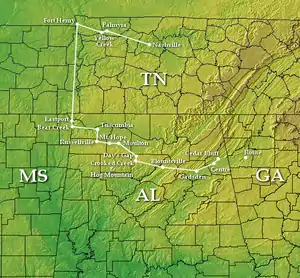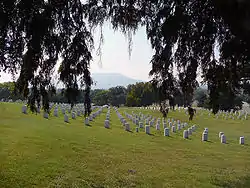80th Illinois Infantry Regiment
The 80th Illinois Volunteer Infantry Regiment was an infantry regiment that served in the Union Army during the American Civil War. The regiment was composed of ten companies that drew primarily from eight southern Illinois counties. Over the course of the war the regiment traveled approximately 6,000 miles, and was in over 20 battles.
| 80th Illinois Volunteer Infantry Regiment | |
|---|---|
 Recruiting flag | |
| Active | 25 August 1862 to 10 June 1865 |
| Country | |
| Allegiance | |
| Branch | Union Army |
| Type | Infantry |
| Engagements | American Civil War |
| Commanders | |
| Initial Colonel | Thomas G. Allen |
| Initial Lt. Colonel | Andrew Rodgers |
| Initial Major | Erastus Newton Bates |
History
Organization and early service
In the summer of 1862 President Lincoln issued calls for more volunteers in the war effort. In July he requested 300,000 men for three years of service, and the next month, on 4 August 1862, he issued a call for 300,000 more men for nine months of service. In part as a patriotic response to these calls, the 80th Illinois Infantry was organized by Colonel Thomas G. Allen at Centralia, Illinois and mustered into service on 25 August 1862.
| Company | Primary County of Recruitment | Earliest Captain |
|---|---|---|
| A | Jackson and Randolph | James L. Mann |
| B | Madison | George W. Carr |
| C | St. Clair | Henry Zeis |
| D | Randolph | Carter C. Williams |
| E | Jefferson | Stephen T. Stratton |
| F | Randolph | Edmund R. Jones |
| G | Perry and Randolph | Andrew Wilson |
| H | Marion and Jefferson | James Cunningham |
| I | Washington | Daniel Hay |
| K | Madison | Alexander Hodge |
The regiment was ordered to Louisville on 4 September 1862, and assigned to the 33rd Brigade, Tenth Division, of the Union Army of the Ohio. Brigadier General William R. Terrill commanded the brigade, Brigadier General James S. Jackson commanded the division, and Maj. Gen. Alexander M. McCook commanded the I Corps.
Battle of Perryville
Private Sam Watkins, 1st Tennessee[1]
In its first principal action of the war the regiment participated in the Battle of Perryville (also known as the Battle of Chaplin Hills) and suffered extensive casualties. The group set out from Louisville on 1 October 1862 under the direction of Maj. Gen. Don Carlos Buell and marched in pursuit of Confederate Gen. Braxton Bragg, passing through Taylorville, Bloomfield and Mackville before engaging in the Battle of Perryville on 8 October 1862. The 80th Illinois fell under the command of Brig. Gen. William R. Terrill (33rd Brigade) and Brig. Gen. James S. Jackson (10th Division). Both Terrill and Jackson were ultimately killed in the battle.

The 33rd Brigade, including the 80th Illinois, were initially charged with guarding the artillery, called Parsons' battery, on the Open Knob, a prominent hill on the northern end of the battlefield facing the Confederate's right flank.[lower-alpha 1] After some Confederate infantry snuck up the hill undetected in the woods, Terrill ordered the 123rd Illinois to mount a bayonet charge down the hill, with the raw and outnumbered troops suffering heavy casualties. At about 3:00 p.m., the 80th Illinois were sent in as reinforcements and resulted in a brief stalemate. Eventually the group was forced to retreat to the next ridge in a disjointed manner that led to much friendly fire.
The battle was the culmination of the Confederate Heartland Offensive (Kentucky Campaign). Confederate Gen. Braxton Bragg's Army of Mississippi[lower-alpha 2] arguably won a tactical victory, having fought aggressively and pushed his opponent back for over a mile. However, the battle is still considered a strategic Union victory, sometimes called the Battle for Kentucky, since Bragg withdrew to Tennessee soon thereafter. The Union retained control of the critical border state of Kentucky for the remainder of the war.
Relative to the number of troops involved,[3] the Battle of Perryville was one of the bloodiest battles of the Civil War. It was the largest battle fought in the state of Kentucky.[4] The 80th Illinois lost 14 killed and 58 wounded, including Lieutenant Von Kemmel killed, Lieutenant Andrews mortally wounded, and Lieutenant Colonel Rodgers and Lieutenant Pace severely wounded. Eyewitness reports suggest that three days after the fight there was still dead bodies lying on the field.[2]
Streight's Raid and capture

In the spring of 1863 the 80th Illinois took part in Streight's Raid in northern Alabama. The raid, led by Colonel Abel D. Streight, was intended to destroy parts of the Western and Atlantic railroad, which was supplying the Confederate Army of Tennessee. But due to poor supplies and poor planning it ended with the defeat and capture of Streight and his men at Cedar Bluff, Alabama, by Confederate General Nathan Bedford Forrest. Streight was additionally hindered by locals throughout his march, while pursued by Forrest, who had the advantage of home territory and the sympathy and aid of the local populace, most famously Emma Sansom.
The actual capture of the forces was achieved by a clever ruse, when Forrest paraded his much smaller force back and forth in front of Streight, convincing Streight that he was opposed by a superior force. After surrendering and being informed of the deception Streight reputedly demanded his arms back for a proper fight, a request cheerfully declined by Forrest.
In addition to arms, Forest's men stole the regiment's blankets, watches and money. The regiment was taken to Rome, Georgia, where they were paroled and then sent in coal cars to Atlanta. From here the officers were sent to Libby Prison while the enlisted men were sent, via Knoxville and Lynchburg, to Richmond, arriving on 13 May 1863. While the officers largely remained imprisoned for the remainder of the war, the enlisted men were sent to City Point before being exchanged for Confederate prisoners.
With Col. Thomas G. Allen having resigned and Lieutenant Colonel Andrew Rodgers and Major Erastus Newton Bates still being prisoners of war, the regiment received a new leader in the form of Lieutenant Herman Steincke.
Chattanooga Campaign

In October and November 1863 the regiment took part in the Chattanooga Campaign,[lower-alpha 3] a series of maneuvers and battles designed to give the Union control of the state of Tennessee, including Chattanooga, known as the "Gateway to the Lower South." During this campaign they were part of the 3rd Brigade (commanded by Colonel Friedrich Hecker), 3rd Division (commanded by General Carl Schurz), and the XI Corps (commanded by General Oliver O. Howard).
On 22 November, the 80th Illinois set out toward Chattanooga and arrived in the evening east of town. The next day, on 23 November, the regiment engaged with the enemy and took the first line of rifle splits as part of the XI Corps, driving on the left flank in the enemy's skirmishers. The 80th Illinois laid in line of battle all night. This advance was part of the Union Army of the Tennessee under Maj. Gen. William T. Sherman maneuvering to launch a surprise attack against Bragg's right flank on Missionary Ridge. Meanwhile, on 24 November, Eastern Theater troops on the opposite side of the line under Maj. Gen. Joseph Hooker defeated the Confederates in the Battle of Lookout Mountain and began a movement toward Bragg's left flank at Rossville.
On 25 November, Sherman's attack on Bragg's right flank, which included the 80th Illinois, made little progress. Hoping to distract Bragg's attention, Grant authorized Thomas's army to advance in the center of his line to the base of Missionary Ridge. A combination of misunderstood orders and the pressure of the tactical situation caused Thomas's men to surge to the top of Missionary Ridge, routing the Army of Tennessee, which retreated to Dalton, Georgia, fighting off the Union pursuit successfully at the Battle of Ringgold Gap.
Bragg's defeat eliminated the last Confederate control of Tennessee and opened the door to an invasion of the Deep South, leading to Sherman's Atlanta Campaign of 1864, of which the 80th Illinois also took part.
Atlanta campaign
During the summer of 1864 the regiment participated in the Western Theater's Atlanta Campaign throughout northwest Georgia and the area around Atlanta. The campaign under the ultimate direction of Union Maj. Gen. William T. Sherman involved a large invading force into Georgia from the vicinity of Chattanooga, Tennessee, and was opposed by the Confederate general Joseph E. Johnston.
Johnston's Army of Tennessee withdrew toward Atlanta in the face of successive flanking maneuvers by Sherman's group of armies. In July, the Confederate president replaced Johnston with the more aggressive John Bell Hood, who began challenging the Union Army in a series of damaging frontal assaults. Hood's army was eventually besieged in Atlanta and the city fell on September 2, hastening the end of the war.
The 80th Illinois was heavily involved in all of the heavy battles of the Atlanta campaign and was constantly exposed to the enemy's fire for about three months. The 80th Illinois commenced its involvement on 3 May 1864 and participated in the battles of Dalton, Resaca, Adairsville, Cassville, Dallas, Pine Mountain, Kenesaw Mountain, Marietta, Peach Tree Creek, Atlanta, Jonesborough and Lovejoy's Station. During the campaign, the Regiment captured about 150 prisoners, and lost 25 killed and 60 wounded.
End of service
The regiment was mustered out on 10 June 1865 and proceeded to Camp Butler, Illinois, for final pay and discharge.
Total strength and casualties
The regiment suffered the loss of 6 officers and 52 enlisted men who were killed in action or who died of their wounds and 160 enlisted men who died of disease, for a total of 218 fatalities.[5] Only four of the captured officers ever returned to the Regiment. The remainder were held as prisoners until 1 March 1865, when they were paroled for exchange.
Command history
| Thomas G. Allen | 26 August 1862 – 21 April 1863 |
| Andrew Rodgers | 21 April 1863 – 3 May 1863 |
| Herman Steincke | 3 May 1863 – |
| James Monroe Stookey | 7 June 1864 – |
| Erastus Newton Bates | 10 May 1865 – |
See also
- List of Illinois Civil War Units
- Illinois in the American Civil War
Citations
- Watkins, Sam. Company Aytch: Or, a Side Show of the Big Show. Cumberland Presbyterian Publishing House, 1882. pp. 80-81. OCLC 43511251.
- Crawford 1979, p. 31.
- Kennedy 1998, p. 127.
- Eicher 2001, p. 367.
- Dyer 1908.
References
- Crawford, James (1979). "Dear Lizzie": Letters Written by James "Jimmy" Garvin Crawford to His Sweetheart Martha Elizabeth "Lizzie" Wilson. New Jersey: Bascom.
- Dyer, Frederick H. (1908). A Compendium of the War of the Rebellion. Madison, Wisconsin: Dyer Publishing Co. Reprint, Dyer, Frederick H. (1979). A Compendium of the War of the Rebellion. Dayton, OH: National Historical Society.[lower-alpha 4]
- Eicher, David J. (2001). The Longest Night: A Military History of the Civil War. New York: Simon & Schuster. ISBN 0-684-84944-5.
- Kennedy, Frances H., ed. (1998). The Civil War Battlefield Guide (2nd ed.). Boston: Houghton Mifflin Co. ISBN 0-395-74012-6.
Notes
- Companies G and B were not engaged in the fight.[2]
- During the battle, correspondence referred to the army as the Army of the Mississippi, deviating from the general rule that only Union armies were named after rivers. It was also sometimes referred to as the Army of the West. The army was activated on March 5, 1862, just before the Battle of Shiloh, and was renamed by Bragg as the Army of Tennessee in November. See Army of Mississippi.
- The National Park Service's Civil War Sites Advisory Commission classifies two campaigns for this period: Reopening the Tennessee River (Battle of Wauhatchie) and Chattanooga-Ringgold (the Third Battle of Chattanooga, frequently known as the Battles for Chattanooga, and the Battle of Ringgold Gap).
- This reference lists battles and campaigns for Union regiments and also gives the composition of corps and armies, i.e., such as the 80th Illinois Volunteer Regiment. Take note, however, that regimental battle lists cannot be considered proof that any particular soldier fought in various battles since different companies in the regiment may have had different assignments, or an individual soldier may have been absent due to sickness, desertion, temporary assignment to other duties, or other causes.